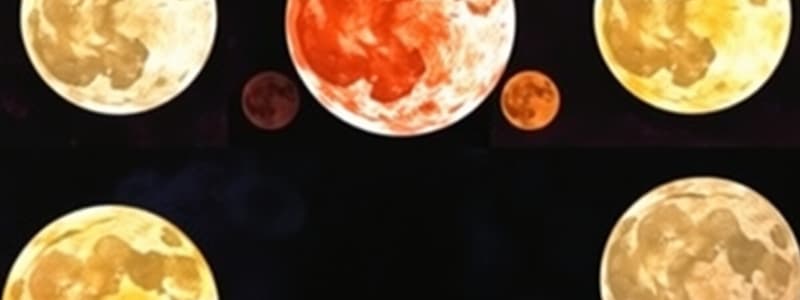Podcast
Questions and Answers
What is the significance of the Moon's formation period of 4.5 billion years ago in the context of solar system history?
What is the significance of the Moon's formation period of 4.5 billion years ago in the context of solar system history?
It marks the Moon's origin shortly after the formation of the solar system, providing insights into the early conditions of planetary development.
Explain the relationship between the Moon's rotation and revolution in terms of its phases as observed from Earth.
Explain the relationship between the Moon's rotation and revolution in terms of its phases as observed from Earth.
The Moon rotates on its axis at the same rate it revolves around Earth, resulting in only one hemisphere being visible from Earth at all times.
Describe the geological composition of the Moon, focusing on its core and crust.
Describe the geological composition of the Moon, focusing on its core and crust.
The Moon has an iron-rich core, a mantle, and a crust primarily composed of various minerals and rocky debris.
What role do meteoroids, comets, and asteroids play in the formation of craters on the Moon's surface?
What role do meteoroids, comets, and asteroids play in the formation of craters on the Moon's surface?
Discuss the significance of the Apollo 11 mission in lunar exploration history.
Discuss the significance of the Apollo 11 mission in lunar exploration history.
Flashcards
Moon's formation age
Moon's formation age
The Moon formed approximately 4.5 billion years ago.
Moon's diameter
Moon's diameter
The Moon's diameter is about 3476 kilometers.
Moon's composition
Moon's composition
The Moon has an iron-rich core, mantle, and crust.
Moon's surface
Moon's surface
Signup and view all the flashcards
Moon's orbit distance
Moon's orbit distance
Signup and view all the flashcards
Study Notes
Moon Formation and Composition
- Formed 4.5 billion years ago
- Fifth largest moon, with a diameter of 3476 km
- Composed of an iron-rich core, mantle, and crust containing minerals
- Surface completely covered in dust and rocky debris
- Contains craters formed by meteoroids, comets, and asteroids
- South Pole-Aitken Basin is the largest crater
- Orbits Earth from a distance of 384,000 km
Moon Rotation and Revolution
- Rotates at the same rate it revolves around Earth
- Same side of the Moon always faces Earth
Moon Phases
- Exhibits eight phases (New Moon, Waxing Crescent, First Quarter, Waxing Gibbous, Full Moon, Waning Gibbous, Last Quarter, Waning Crescent)
- 20.7.1969 - Apollo 11 landed on the moon
Studying That Suits You
Use AI to generate personalized quizzes and flashcards to suit your learning preferences.




